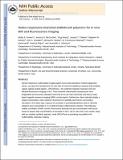| dc.contributor.author | Sowers, Molly A. | |
| dc.contributor.author | McCombs, Jessica R. | |
| dc.contributor.author | Wang, Ying | |
| dc.contributor.author | Paletta, Joseph T. | |
| dc.contributor.author | Morton, Stephen Winford | |
| dc.contributor.author | Boska, Michael D. | |
| dc.contributor.author | Ottaviani, M. Francesca | |
| dc.contributor.author | Rajca, Andrzej | |
| dc.contributor.author | Johnson, Jeremiah A. | |
| dc.contributor.author | Hammond, Paula T | |
| dc.contributor.author | Dreaden, Erik | |
| dc.date.accessioned | 2016-02-16T13:46:51Z | |
| dc.date.available | 2016-02-16T13:46:51Z | |
| dc.date.issued | 2014-11 | |
| dc.date.submitted | 2014-05 | |
| dc.identifier.issn | 2041-1723 | |
| dc.identifier.uri | http://hdl.handle.net/1721.1/101184 | |
| dc.description.abstract | Stimuli-responsive multimodality imaging agents have broad potential in medical diagnostics. Herein, we report the development of a new class of branched-bottlebrush polymer dual-modality organic radical contrast agents—ORCAFluors—for combined magnetic resonance and near-infrared fluorescence imaging in vivo. These nitroxide radical-based nanostructures have longitudinal and transverse relaxation times that are on par with commonly used heavy-metal-based magnetic resonance imaging (MRI) contrast agents. Furthermore, these materials display a unique compensatory redox response: fluorescence is partially quenched by surrounding nitroxides in the native state; exposure to ascorbate or ascorbate/glutathione leads to nitroxide reduction and a concomitant 2- to 3.5-fold increase in fluorescence emission. This behaviour enables correlation of MRI contrast, fluorescence intensity and spin concentration with tissues known to possess high concentrations of ascorbate in mice. Our in vitro and in vivo results, along with our modular synthetic approach, make ORCAFluors a promising new platform for multimodality molecular imaging. | en_US |
| dc.description.sponsorship | Massachusetts Institute of Technology. Department of Chemistry | en_US |
| dc.description.sponsorship | Massachusetts Institute of Technology. Research Support Committee | en_US |
| dc.description.sponsorship | Lincoln Laboratory | en_US |
| dc.description.sponsorship | National Institutes of Health (U.S.) (NIBIB 1R21EB018529-01A1) | en_US |
| dc.description.sponsorship | National Institutes of Health (U.S.) (Ruth L. Kirschstein National Research Service Award 1F32EB017614-01) | en_US |
| dc.description.sponsorship | United States. Dept. of Defense. Ovarian Cancer Research Program (Teal Innovator Award) | en_US |
| dc.description.sponsorship | National Cancer Institute (U.S.) (Koch Institute Support (Core) Grant P30-CA14051) | en_US |
| dc.language.iso | en_US | |
| dc.publisher | Nature Publishing Group | en_US |
| dc.relation.isversionof | http://dx.doi.org/10.1038/ncomms6460 | en_US |
| dc.rights | Creative Commons Attribution-Noncommercial-Share Alike | en_US |
| dc.rights.uri | http://creativecommons.org/licenses/by-nc-sa/4.0/ | en_US |
| dc.source | PMC | en_US |
| dc.title | Redox-responsive branched-bottlebrush polymers for in vivo MRI and fluorescence imaging | en_US |
| dc.type | Article | en_US |
| dc.identifier.citation | Sowers, Molly A., Jessica R. McCombs, Ying Wang, Joseph T. Paletta, Stephen W. Morton, Erik C. Dreaden, Michael D. Boska, et al. “Redox-Responsive Branched-Bottlebrush Polymers for in Vivo MRI and Fluorescence Imaging.” Nature Communications 5 (November 18, 2014): 5460. | en_US |
| dc.contributor.department | Massachusetts Institute of Technology. Institute for Soldier Nanotechnologies | en_US |
| dc.contributor.department | Massachusetts Institute of Technology. Department of Chemical Engineering | en_US |
| dc.contributor.department | Massachusetts Institute of Technology. Department of Chemistry | en_US |
| dc.contributor.department | Koch Institute for Integrative Cancer Research at MIT | en_US |
| dc.contributor.mitauthor | Sowers, Molly A. | en_US |
| dc.contributor.mitauthor | McCombs, Jessica R. | en_US |
| dc.contributor.mitauthor | Morton, Stephen Winford | en_US |
| dc.contributor.mitauthor | Dreaden, Erik Christopher | en_US |
| dc.contributor.mitauthor | Hammond, Paula T. | en_US |
| dc.contributor.mitauthor | Johnson, Jeremiah A. | en_US |
| dc.relation.journal | Nature Communications | en_US |
| dc.eprint.version | Author's final manuscript | en_US |
| dc.type.uri | http://purl.org/eprint/type/JournalArticle | en_US |
| eprint.status | http://purl.org/eprint/status/PeerReviewed | en_US |
| dspace.orderedauthors | Sowers, Molly A.; McCombs, Jessica R.; Wang, Ying; Paletta, Joseph T.; Morton, Stephen W.; Dreaden, Erik C.; Boska, Michael D.; Ottaviani, M. Francesca; Hammond, Paula T.; Rajca, Andrzej; Johnson, Jeremiah A. | en_US |
| dc.identifier.orcid | https://orcid.org/0000-0002-4954-8443 | |
| dc.identifier.orcid | https://orcid.org/0000-0001-9157-6491 | |
| mit.license | OPEN_ACCESS_POLICY | en_US |
